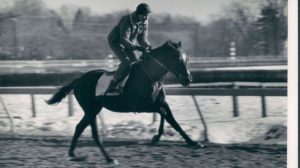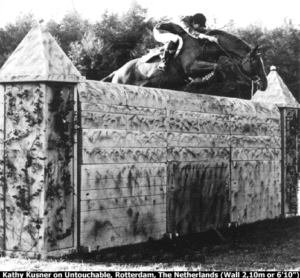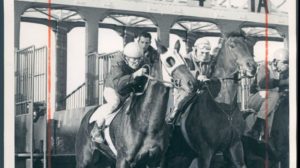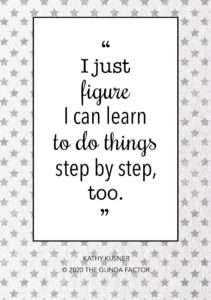
Awesome Athlete
She worked in a stable in exchange for riding lessons and ended up competing in the Olympics as a member of the United States Equestrian Team. But being one of the best riders in the country wasn’t enough to gain entry to the racing world if you were a woman. After waiting 4 years for someone else to challenge the ban, she gathered her courage and did it herself, becoming the first woman in the United States to get a jockey license. Travel back in time to 1968 and meet Kathy Kusner…
Her Ruby Shoe Moment
The Power of the Wand
Her Yellow Brick Road
Brains, Heart & Courage
Glinda’s Gallery
Just the Facts
Her Ruby Shoe Moment
Kathy Kusner urged her horse forward as she galloped around the oval at Maryland’s Saratoga Race Track for a practice run. She had spent several years competing in show jumping events for the U.S. Equestrian Team and loved the thrill of flying over fences. But after hundreds of competitions, including three Olympic Games, Kathy had been ready for a new challenge and found it at the race track.
 Her one frustration with her new career was that she wasn’t allowed to race in any official events. In equestrian, men and women competed against each other, but not in racing. It simply was understood that a Racing Commission would never issue a woman a jockey license. Women were allowed to exercise horses in the morning as a service to owners and male jockeys, and women jockeys in unlicensed races were tolerated. But when it came to the official afternoon races, women were expected to join the crowd cheering on the men.
Her one frustration with her new career was that she wasn’t allowed to race in any official events. In equestrian, men and women competed against each other, but not in racing. It simply was understood that a Racing Commission would never issue a woman a jockey license. Women were allowed to exercise horses in the morning as a service to owners and male jockeys, and women jockeys in unlicensed races were tolerated. But when it came to the official afternoon races, women were expected to join the crowd cheering on the men.
As Kathy pulled the reins to get her horse to stop, she realized she was tired of waiting for someone else to challenge the Racing Commission. When the Civil Rights Act of 1964 passed 4 years earlier, Kathy had been optimistic that its ban of sex based discrimination would change things. She didn’t want to be the first woman to apply for a jockey license, because she feared making enemies in the racing community. Since all the other women riders shared the same fear, nothing had happened. Kathy wanted more and decided she should stop waiting for someone else to get it for her. 
Kathy got a referral to a lawyer named Audrey Melbourne. At their first meeting, Kathy offered Audrey her $1500 life savings. Audrey agreed to represent Kathy, but turned down the money because wanted to be part of a landmark case. Audrey did have one condition: Kathy had to stay away from the race track until the case was resolved.
Kathy planned to submit her jockey application in person to Fred Caldwell, the head of the Maryland Racing Commission. Audrey called the press to build public sympathy for Kathy. When Kathy arrived at the Racing Commission Office, newspaper reporters and television news cameras were already there. Kathy tried to give Fred her application and he refused to take it. Kathy kept moving toward him with the application in her outstretched hand and Fred kept backing away. After a few minutes of this dance, Kathy set the application on Fred’s desk and walked out of the office. It became the story of the night on television news, which played the video of the entire interaction.

Kathy and her lawyer, Audrey (Laurel Leader File)
Kathy and Audrey attended three Racing Commission hearings over the next year to request that they review Kathy’s application. Their strategy was to show that Kathy was willing to work within the system, but the system wasn’t willing to work with her. The Racing Commission wouldn’t budge, even though Kathy was more qualified than most men who applied.
The women took the next step of filing a lawsuit against the Racing Commission. At the first hearing, the judge took 3 minutes to rule in Kathy’s favor based on the Civil Rights Act. He declared that since Kathy’s application would have been approved if she was a man, it must be approved period. He awarded Kathy a jockey license on the spot. Other state commissions accepted his decision as precedent and the door was open for women in racing.
The Power of the Wand
Kathy was the first licensed woman jockey in the United States. Her license allowed her to compete internationally, and since most countries also didn’t license women, she became the first woman to race in Mexico, Germany, Chile, Peru, Panama, South Africa, and Rhodesia (now Zimbabwe).
One of the women who walked through the door Kathy opened is Rosie Napravnik. Rosie got her jockey license when she was 17. In 2013, when she was 25, she became the first woman to compete in the Triple Crown races in the same season. She placed 5th in the Kentucky Derby, 3rd in the Preakness, and 6th in the Belmont Stakes.
Her Yellow Brick Road
Kathy started her riding career as a show jumper. Her big break came when she was 18 and won the division championship at the Pennsylvania National Horse Show with one of her favorite horses, Unusual. The U.S. Equestrian Team was looking for some additional talent for the first Washington International Horse Show and asked Kathy to compete with them the following week. Kathy agreed, the team won, and the U.S. Equestrian Team invited her to train with them.

Kathy and her 1964 U.S. Equestrian Teammates (Dublin Evening Argus)
Kathy quickly made a name for herself, earning a Horsewoman of the Year honor when she was 21. Her success was impressive given that most owners with the “best” horses wanted men to ride them. Owners of horses with quirks or flaws were the ones willing to take a chance on Kathy, and she developed a talent for turning a challenging horse into a champion. She appreciated each horse’s unique personality and modified her training based on how the horse responded best. She realized Unusual liked a soft bit which helped him float through the air, and the two of them won a gold medal with the U.S. Team at the Pan American Games in Brazil in 1963.
Kathy started working with another horse, Untouchable, that same year. Untouchable was a Thoroughbred and he and Kathy quickly bonded. Like she did with Unusual, Kathy worked with Untouchable’s quirks to get the best out of him. He was a “hot horse” who accelerated from the starting line to the first jump so quickly that he often went over it sideways. Kathy noticed he loved a walk or slow trot in the sun, and was less excited in competition if he got one. She developed a pre-race routine that made time for a walk just before the two of them entered the course.

Kathy and Untouchable
Kathy and Untouchable went to Tokyo in 1964 for their first Olympic Games. They were in Canada for the 1967 Pan Am Games, earning a team silver medal. Two more Olympic Games followed: Mexico City with Untouchable in 1968 and Munich with Fleet Apple in 1972. In Munich, Kathy became the first American woman to win an Olympic medal in an equestrian event when the team earned silver.
When she wasn’t representing the United States, Kathy traveled the world competing in horse shows on her own, typically finishing at the top of the pack. She twice was the leading rider at the International Horse Show at Madison Square Garden. She won several Grand Prix competitions all over Europe. Some of the most memorable were in Germany, where she cleared a 6’10” fence on Untouchable and a 7’2” fence on a different horse the following year.
Once Kathy reached the pinnacle of show jumping, she decided to try racing to challenge herself. Her first attempt was a pony race. She was given a tiny pony that looked like a “bag of fur” and offered another rider $1 to trade ponies with her. He said no, so she urged her bag of fur ahead for the win. She started working at the track, exercising as many as 18 horses for trainers each morning, and hoping for a chance to race.

Kathy at the racetrack (Laurel Leader File)
Since Kathy didn’t have a jockey license, she could only ride in non-licensed races. The Culpepper track, where many unlicensed races took place, could be a tough environment. There was no official starting gate, the track was uneven terrain, and many jockeys raced while drunk. But it was a place where Kathy was allowed to race, so she made it work.
Having a winning stable made the horses in it more valuable, so owners hired riders who could win. She said yes to every job that came her way. The more unlicensed races Kathy won, the more offers she got. As her reputation grew, she had the chance to ride more talented horses. She began riding at Saratoga, one of the best known tracks, and then decided it was time to challenge the racing commission so she could take her place at an official starting line.
Brains, Heart & Courage

Kathy (Laurel Leader File)
Kathy was simply a girl who loved horses. When she was little, she would beg her parents to stop at fields so she could pet them. Neither of Kathy’s parents rode, so they signed her up for riding lessons at the Jane Marshall Dillon Junior Equitation School in Vienna, Virginia. Tuition was very expensive, so they struck a deal with Mrs. Dillon where Kathy worked in the stable in exchange for her lessons.
 Every weekend, Kathy’s parents drove her out to Mrs. Dillon’s barn. When she wasn’t riding, she was learning how to clean stables and groom the horses. Many of the grooms were African American, which was a new experience for Kathy because Virginia schools were segregated. Kathy made interracial friendships for the first time, and started learning how segregation affected her friends on a daily basis. Things she took for granted, like eating in a restaurant, weren’t options for them. At horse shows, in order for them to eat together, Kathy would have to go inside to buy the food and then bring it out to her friends.
Every weekend, Kathy’s parents drove her out to Mrs. Dillon’s barn. When she wasn’t riding, she was learning how to clean stables and groom the horses. Many of the grooms were African American, which was a new experience for Kathy because Virginia schools were segregated. Kathy made interracial friendships for the first time, and started learning how segregation affected her friends on a daily basis. Things she took for granted, like eating in a restaurant, weren’t options for them. At horse shows, in order for them to eat together, Kathy would have to go inside to buy the food and then bring it out to her friends.
Kathy wanted to be chosen to ride at horse shows, so she learned to braid manes and tails to make herself an essential part of the team. No job was too big or small. When she finally got her chance to ride one of Mrs. Dillon’s horses at a show, she made a big impression. Her dedication to training paid off, she rode beautifully, and horse owners started asking her to ride for their horses.
Glinda’s Gallery
Just the Facts
- Kathy was born in Gainesville, Florida in 1940. She grew up in Virgina.
- Kathy never owned her own horse during her show jumping and racing career.
- Kathy earned pilot’s licenses with commercial, multi-engine, instrument, seaplane and commercial glider ratings. She was rated to fly the Lear Jet 23 and 24 and was the first woman to work as a pilot for Executive Jet Aviation, then the largest air charter company in the world. Sometimes she would rent a small plane to fly to some of the small tracks to compete.
- The old guard tried one last time to keep Kathy out. One of her first official races as a jockey was the Maryland Hunt Cup, a world-famous “timber race” through hills, valleys, and fences as high as 4’10”. Some members of the Cup’s Board of Directors tried to bar her from competing, but her jockey license prevented them from taking any formal action against her. ABC filmed an award-winning documentary about Kathy being the first woman to compete in the Maryland Hunt Cup.
- Kathy was also an avid runner, finishing 123 marathons and 73 ultramarathons. Her longest race was the Vermont 100 Mile Endurance Race which she finished in 27 hours and 37 minutes. She is still running at age 80.
- Kathy has been an equine expert witness since 1983. She is hired to provide her professional opinion in lawsuits related to horse related accident analysis, reconstruction, and prevention, as well as horse behavior, and equine industry standards.
- Kathy has taught riding clinics around the world (from France, Italy, and Spain to Zimbabwe, Peru, Iran, and Paraguay)
- Kathy has worked as a TV commentator for Grand Prix events, designs courses nationally and internationally, and writes for publications.
- Kathy retired from racing and moved to California, where she founded “Horses in the Hood,” a non-profit organization “benefiting the inner-city community by providing lessons that teach skills and values associated with the care and riding of horses.” Since 1999, HHLA has sponsored more than 1,411 at-risk children at its 5 day horse camp in Mill Creek.
- Kathy’s awards include:
- 1960 Association of American Horse Shows “Horsewoman of the Year”
- 1990 Show Jumping Hall of Fame
- 2000 The Chronicle of the Horse and the Association of American Horse Shows “50 Most Influential Horsemen of the 20th Century”
- 2000 Virginia Horse Shows Association Hall of Fame
- 2005 United States Equestrian Federation Pegasus Medal of Honor
- 2005 World Sports Humanitarian Hall of Fame
- 2012 John Henry “Pop” Lloyd Humanitarian Award
- 2016 California Professional Horseman’s Association Hall of Fame
- 2017 Washington International Horse Show Hall of Fame
- 2017 Upperville Horse Show “Wall of Honor” with “High Noon”
Want to Know More?
Brown, Liz “Kathy Kunser Equestrian Rebel” (Horse Network Apr. 6, 2020)
Horses & History, Kathy Kusner: Jack of All Trades. Master of All. (Horse Canada Dec. 3, 2004)
Jamieson, Ann “Kathy Kusner: Boldly Going Where No Woman Has Gone Before” The Plaid Horse (Jan. 27, 2020).
Show Jumping Hall of Fame (1990)
Wood, Jennifer Kathy Kusner Inducted Into WIHS Hall of Fame
